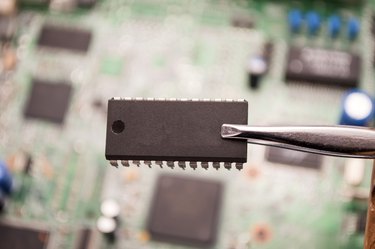
Computers are made from a plethora of different metals, plastics, alloys and other materials. Some materials are common, like copper, while others are more unfamiliar, like 7,7,8,8-tetracyanoquinodimethane, and some are even incredibly rare. While some of the materials used in your computer parts can be hazardous, modern systems use fewer and less dangerous toxic and poisonous components.
Made of Metals
Video of the Day
Common metals like copper, lead and gold are used on a variety of computer parts. For example, lead can be used as a solder, radiation shielding and as a plastic stabilizer in PVC cabling. Gold is often used for pin plating, and copper is used as a conductor, but also used on hard disks along with aluminum, magnesium, silicon and zinc. There are also certain alloys on hard disk platters like cobalt, nickel and iron. Metals are commonly found on computer casings, from steel and anodized aluminium to carbon fiber.
Video of the Day
Prepped With Plastics
Plastics in computers are used for two main purposes. While some are used as insulation to protect computer parts against heat, some are used in capacitors, which conduct electricity. These are called polymer capacitors, and many are based on the organic compound 7,7,8,8-tetracyanoquinodimethane. Some computer casings contain plastic, but these are generally lower quality as opposed to their metal counterparts. Plastics are also capable of creating complete electronic circuits, though silicon is still more effective.
Rare and Remarkable Resources
Many rare materials, primarily metals, are used in the construction of computer parts. For example, high-performance hard disks use a material called ruthenium, which is rarer than both gold and platinum. Others include neodymium, gallium, lutetium, tantalum and rutherfordium, which can all be found in insulators, transistors and processors. Another material used in processors, hafnium, may run out completely in approximately 10 years at its current rate of consumption, though zirconium may be a viable replacement.
Health Hazards
Many pieces of computer hardware include lead and mercury; lead and mercury toxicity can cause problems in the central nervous system, liver and other organs. Bromine can be found inside many internal computer parts and toxic substances known as phthalates can be found on products containing polyvinyl chloride, which can include the plastic coating on cables. Lead and mercury can also be found in liquid crystal displays, as well as copper in excess of regulatory limits. While just handling computer parts on a normal basis isn't enough to cause many problems, certain effects can be cumulative, and they also effect how you can recycle old parts.
Creating Crystal Displays
Liquid crystal displays operate by using electric currents to charge segments of liquid crystals, which are arranged in rows and columns, to create what you see on your screen. The crystals are surrounded by polymer, indium tin oxide, silicon dioxide and glass on either side. You can also find various metals and plastics on most monitors as part of the monitor's casing and various ports. Because of the materials used in LCD screens, some states have strict laws regarding how you must recycle them, and they should not be tossed in the trash.
- TechRepublic: What IT Pros Should Know About Exposure to Hazardous Materials
- TechRadar: The Weird and Wonderful Materials That Make up Your PC
- Elated Directory: Raw Materials Used In the Creation of Electronics
- OECD: The Evolution of Materials Used in Personal Computers
- MadeHow: Liquid Crystal Display (LCD)
- Earth911: How to Recycle Computer Monitors